#Tribal-class destroyer
Explore tagged Tumblr posts
Video
youtube
A Brief History: Tribal-Class Destroyer
#youtube#A Brief History#Tribal-Class Destroyer#Tribal Class Destroyer#World War 2#Nautical History#How the Turns Table#WW2#World War II#WWII#Original Content
2 notes
·
View notes
Text
🏳️🌈
Place: HMCS Haida
📍 Hamilton,ON
June/ 2024
#tumblr#canada#canadian#lunaluks#HMCS Haida#ship#war ship#Tribal-class destroyer#lgbt#lgbtq#lgbtqia#summer#2024
0 notes
Text
Although the lieutenant commander with the hardware on his neck had sunk 250,000 gross register tons, a light cruiser of the Despatch class and a heavy destroyer of the Tribal class, the details of his exploits took up much less space in his talk than verbose descriptions of nature. No metaphor was too daring. For instance: “…swaying like a train of priceless, dazzlingly white lace, the foaming wake follows the boat which, swathed like a bride in festive veils of spray, strides onward to the marriage of death.
— Gunter Grass, Cat and Mouse
1 note
·
View note
Text
German Channel
28 August
The Task Force Operation Last Testicle has launched an "assault" on the beaches of Roscoff
Battleships:
HMS Warspite (Queen Elizabeth-class)
HMS Resolution (Revenge-class)
HMS Royal Sovereign (Revenge-class)
Cruisers:
HMS Renown (Renown-class)
HMS Repulse (Renown-class)
HMS Exeter (York-class)
HMS York (York-class)
HMS Orion (Leander-class)
HMS Sheffield (Southampton-class)
Destroyers:
HMS Javelin (J-class)
HMS Jupiter (J-class)
HMS Mohawk (Tribal-class)

All of these ships have landed at the beaches of Roscoff. They were confused about their orders.
0 notes
Text
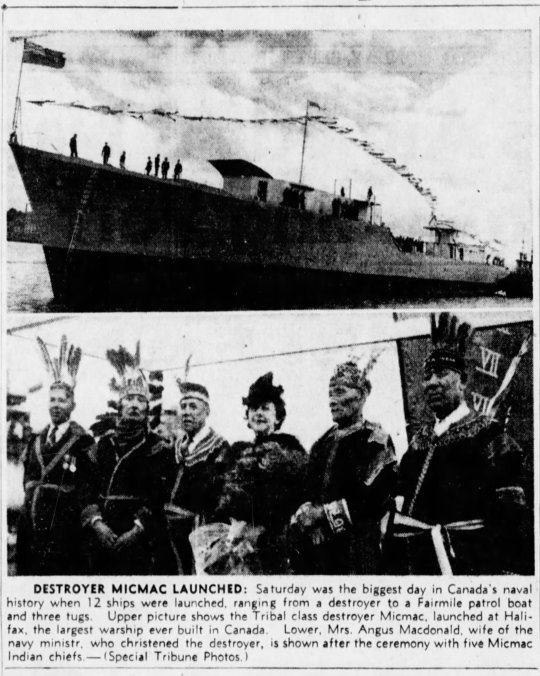
"DESTROYER MICMAC LAUNCHED: Saturday was the biggest day in Canada's naval history when 12 ships were launched, ranging from a destroyer to a Fairmile patrol boat and three tugs. Upper picture shows the Tribal class destroyer Micmac, launched at Halifax, the largest warship ever built in Canada. Lower, Mrs. Angus Macdonald, wife of the navy minister, who christened the destroyer, is shown after the ceremony with five Micmac Indian chiefs. - (Special Tribune Photos.)" - from the Winnipeg Tribune. September 20, 1943. Page 2.
#halifax#mi'kmaq#ship christening#ship launch#royal canadian navy#hmcs micmac#tribal class destroyer#settler colonialism#settler colonialism in canada#first nations#indigenous people#indigenous history#canada during world war 2#world war ii
3 notes
·
View notes
Photo




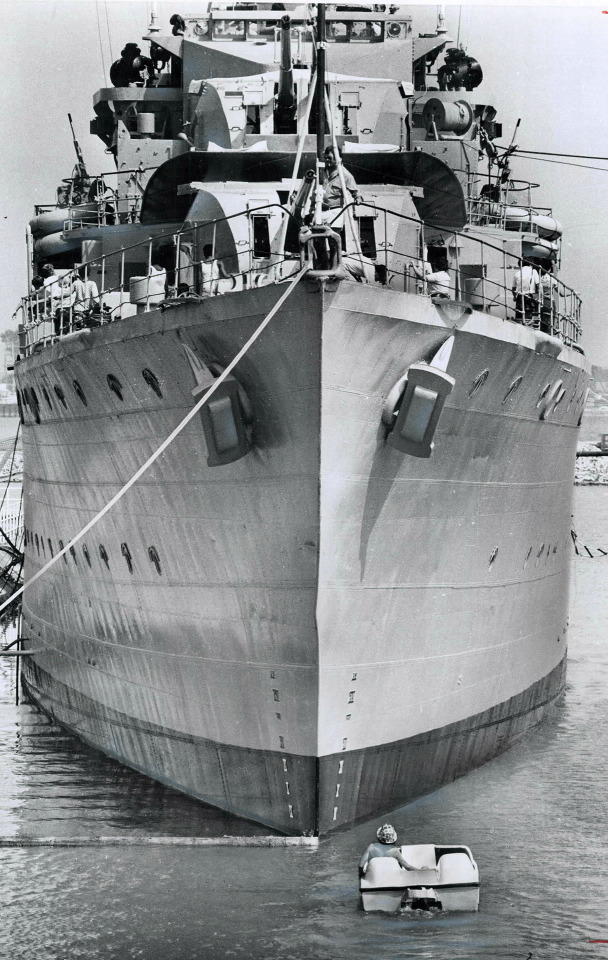
HMCS Haida, Tribal-Class Destroyer, The Fightingest Ship of the Royal Canadian Navy, Decommissioned in 1963 she now serves as a museum ship in Hamilton, Ontario.
12 notes
·
View notes
Text
Destroyers of World War Two: An International Encyclopedia :: M. J. Whitley
Destroyers of World War Two: An International Encyclopedia :: M. J. Whitley
Destroyers of World War Two: An International Encyclopedia :: M. J. Whitley soon to be presented for sale on the astounding BookLovers of Bath web site! London: Cassell, 2002, Paperback. Includes: Black & white photographs; Black & white drawings; Tables; From the cover: Fast, compact and formidable, destroyers were in the thick of the action in every theatre of operations during the Second World…

View On WordPress
#0-304-35675-1#20th century naval operations#20th century warships history#books written by m j whitley#british admiralty#british tribal class#destroyers#destroyers history#first american destroyers#german ships#naval operations#navy#royal navy#torpedo boat#warships history#whitehead propelled torpedo
0 notes
Photo

HMCS Sioux entering Esquimalt Harbour, circa 1950-1963 Canada. Department of National Defence Library and Archives Canada, CT113
#warship#destroyer#tribal class destroyer#hmcs sioux#royal canadian navy#rcn#esquimalt#blue ensign#library and archives canada
18 notes
·
View notes
Text
Star Wars Alien Species - Devaronian
Devaron was the home world of the Devaronians. It was located in the Colonies, near the Corellian Trade Spine. It was a planet of low mountains and deep valleys linked by thousands of rivers.

First devising the tumble hyperdrive around 27,000 BBY, Devaronians were one of the first species in the galaxy to develop interstellar travel. The males of the species had been common sights in spaceports throughout the galaxy for thousands of years by the time of the Galactic Civil War.
Devaronian males were driven by an urge to wander, usually taking the first opportunity to move on from one place to another. As such, they were often found traveling the galaxy as tramp freighter captains and scouts. Female Devaronians, on the other hand, were content to remain in a single location, and, as such, raised the young and ran the government of Devaron. The males sent as much money as they could manage back to their homeworld to support their families, but otherwise hardly ever returned once they had begun to travel the stars. The females were content with this arrangement, as they tended to view the restless males as disruptive to home life. Mating rituals consisted of the season of Koh'hibril. Females were dominant therefore, as that was the only time couples spend long periods together. "Oshmahr" was a mid-day meal ceremony of the Devaronians.
Force-sensitivity was found in higher frequencies among Devaronians than in other species. Despite this, no strong Force-based tradition emerged on Devaron or among their colonies. The Jedi Order established the Eedit Temple on Devaron to train the Forceful children there, with females making up the larger percentage of students as males desired to travel more than the Jedi culture permitted.
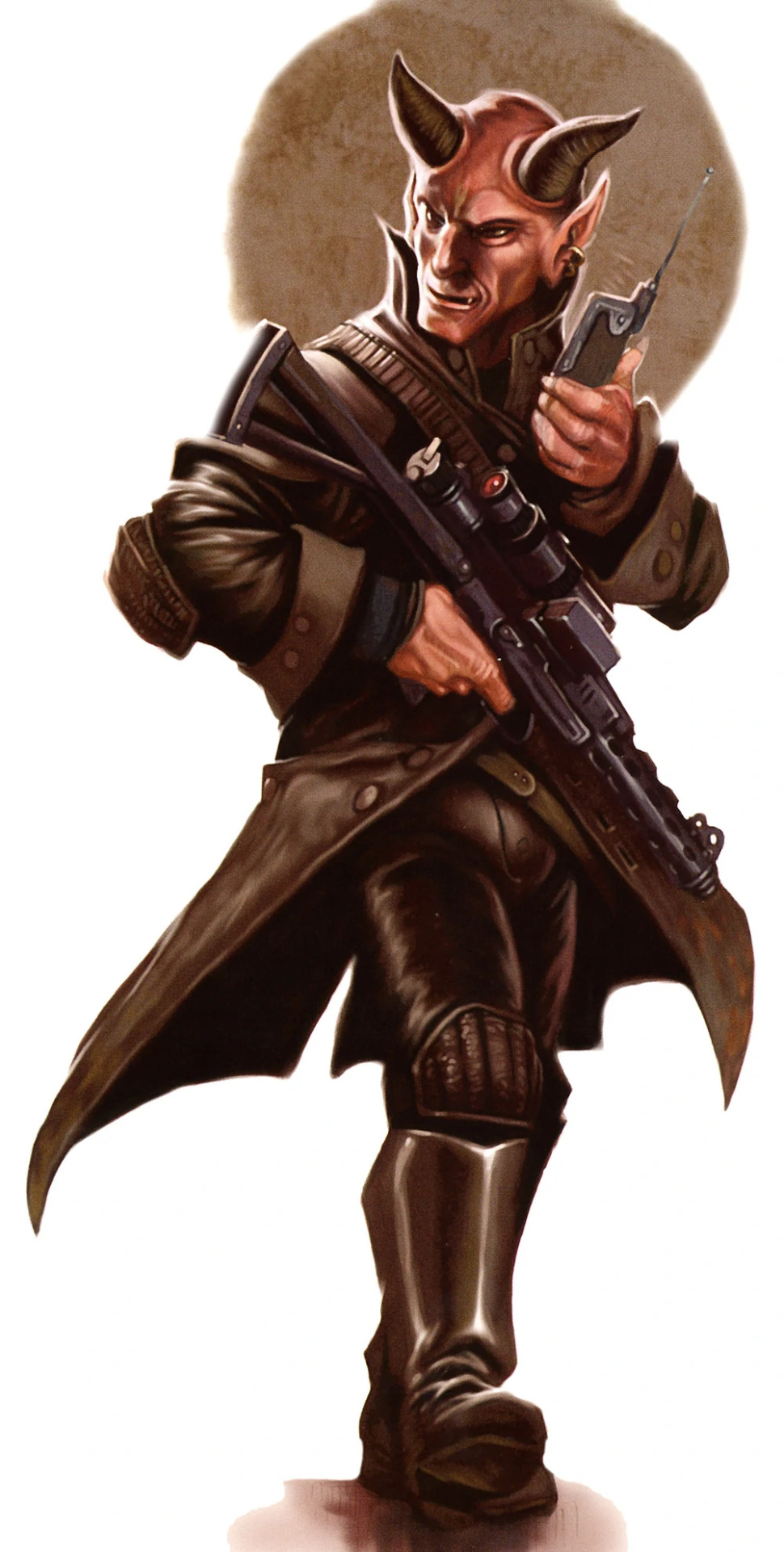
Developing hyperspace technology as early as 30,000 BBY, the Devaronian culture had developed quickly from hunter-gatherers to an industrial power in a short amount of time. The species developed a divide in gender roles during their tribal stage when males had to travel several days from settlements to hunt for prey while the females maintained the safety and organization of the camp. While the matriarchal government developed and funded space technology, it was the wanderlust of the males which drove the species to the stars and beyond. Exploring the region of space around Devaron, Devaronian explorers made contact with other hyperspace scouts and helped blaze the Corellian Trade Spine. One of the earliest planetary governments to join the Galactic Republic, sometime between 25,000 BBY and 22,000 BBY, Devaron was one of the farthest points in known space, forming a border with Wild Space for millennia.
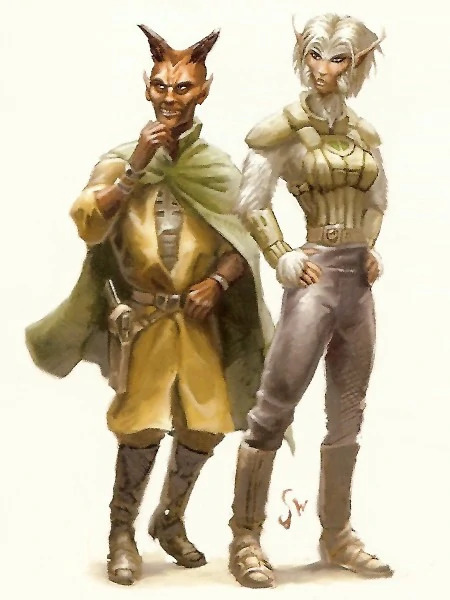
While the government of Devaron was a representative government that matured to a point where the strict divisions between gender roles was blurred, Devaronian females were historically the most prestigious government officials. To this end, the government was largely matriarchal, as males sought out roles that better suited their primal wanderlust that drove them into the jungles or the stars.
During the Jedi Civil War, the planet was the site of a battle won by the Republic. Devaron was represented in the Galactic Senate jointly by Elsah'sai'Moro and Vien'sai'Malloc during the final days of the ancient democracy. However, in 22 BBY, Elsah was assassinated by Aurra Sing who had been hired by Vien, who was herself arrested (and presumably executed) for both her assassination attempt and her secret sponsoring of a Separatist base in the Blue Mountains. In that same year, bounty hunter Cad Bane attacked a Republic outpost on the planet in order to capture Jedi Master Bolla Ropal, who was the keeper of the Kyber memory crystal, which contained a list of Force-sensitive children in the Galaxy. Later, Jedi Knight Anakin Skywalker and his Padawan Ahsoka Tano arrived in the Star Destroyer Resolute in order to reclaim the holocron. During the battle, the Resolute later engaged Bane's Munificent-class star frigates. Bane managed to escape, but the bounty hunter fleet was destroyed.
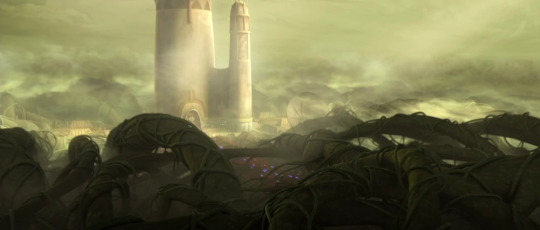
Later in the war, the Temple of Eedit on Devaron was attacked by Separatist forces. This battle was the first appearance of Count Dooku's new apprentice Savage Opress and where Jedi Halsey and his Padawan Knox died. Under President Aven'sai'Ulrahk, the planet continued to support the Republic throughout the rest of the war before falling under the sway of the Galactic Empire following the war's end. Around 5 BBY, Devaron was the site of an uprising against the Empire, which was put down by the Imperial-aligned Devaronian Army, led by Kardue'sai'Malloc, whom was thus called the "Butcher of Montellian Serat". To escape persecution, the Butcher fled to Tatooine and changed his name to Labria. In 19 ABY, Boba Fett captured Labria and took him to Devaron, where the Butcher was executed.
The planet was denied membership in the New Republic due to its violent capital punishment. During the Yuuzhan Vong War, the planetary government of Devaron attempted to appease the Yuuzhan Vong by offering Jedi Knight Hivrekh'wao'Cheklev, who was able to escape. Some female Devaronians wished to join the Galactic Alliance and proposed a termination to feeding criminals to the quarra. However, they met with strong resistance from traditionalists.
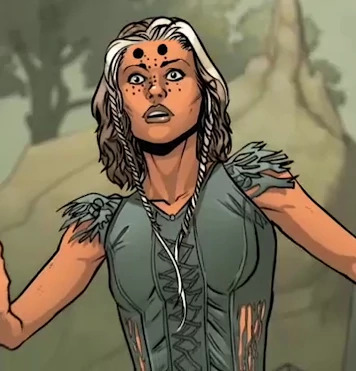
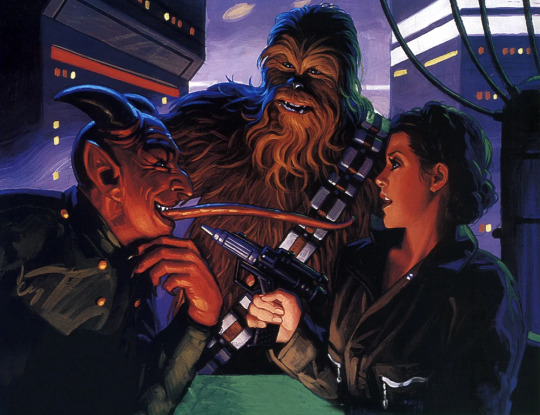
A bipedal mammalian species, Devaronians evolved in the dense jungles of Devaron as a hunter-gather species. Their bodies were denser than most humanoids' and as a result they were heavier than their appearance would tend to indicate. Devaronians had silver-based blood, which appeared thick and black when exposed. They possessed a unique blood filtration and cleansing system which processed through two livers. Because their bodies were constantly cleansed of toxins and carcinogens, the species was highly resistant to poison. To this end, sulfur was used as a stimulant on Devaron to enhance speed and strength, because inhaling it caused the substance to enter the bloodstream rapidly. Their livers struggled to eliminate sulfur from their system, meaning that long-term use could be dangerous.
The Devaronians were one of the more unusual races in the galaxy, with a dramatic gender dimorphism in appearance and temperament. The males were aggressive by nature, many being described as brash or bull-headed, with typically red-tinted skin and a pair of large horns growing from their heads. They took great pride in their horns, and groomed them quite regularly. Many species felt uncomfortable in their presence, for they resembled the devils of a thousand different myths.
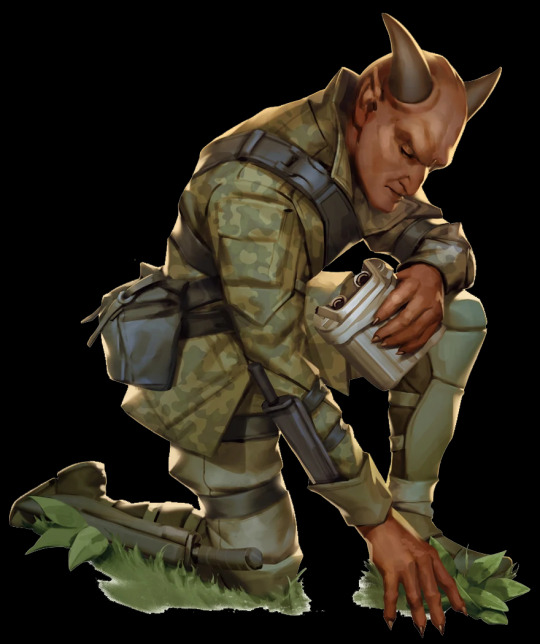
Female Devaronians were covered in thick fur that ranged in color from brown to white, hornless and had prominent canine teeth. They were docile, non-aggressive creatures. They tended to be dominant in their culture, being the only ones allowed to participate in government and politics. Several female Devaronians not covered with thick fur revealed two dark circles above the forehead, where the horns usually were in males. In addition, the teeth of the males were all sharp incisors, but the females also had molars and prominent canines. One in fifty Devaronian males had two sets of teeth, however, having an inner set of sharp "male" teeth and an outer, retractable set of "female" teeth. In primitive times, such males were used as solitary scouts by Devaronian tribes, since they could survive on either meat or plants. Males also had an extremely long tongue, though whether females shared this trait is unknown. The teeth were useful for some languages. A Devaronian had to continually and repeatedly retract and extend both sets of teeth to speak Huttese, causing aches over time.
A typical Devaronian stands at 1.7 meters or 5.6 feet tall and weighs 70 kilograms or 154 pounds.
Devaronians age at the following stages:
1 - 12 Child
13 - 17 Young Adult
18 - 44 Adult
45 - 64 Middle Age
65 - 79 Old
Examples of Names: Dmaynel Kiph, Elassar Targon, Jubal, Kapp Dendo, Tyrn Jiton, Lak Jit, Oxbel, Saricia, Sires Vant, Trynic, Ulicx Vinaq, Vilmarh Grahrk.
Languages: Devaronians speak, read, and write both Devaronese and Basic. Their speech is low, guttural, and full of snarling consonants.
22 notes
·
View notes
Video
youtube
Airfix - Naval History Series - Tribal-Class Destroyers - 1/1200 - Complete Model Building Video
#youtube#Original Content#Airfix#Airfix Model#Airfix Models#Naval History Series#Model Building#Tribal-Class Destroyer#Tribal Class Destroyer#HMS Cossack#Model Ship#Model Ships#Model Kit#World War 2#WW2#World War II#WWII
0 notes
Photo

1941 04 16 RM Tarigo - Paul Wright
On April 16, 1941, Folgore-class destroyers Lampo and Baleno and Navigatori-class destroyer Tarigo were escorting a five-ship convoy when it was attacked by four large British Tribal-class destroyers. The British encountered Baleno first and soon left her a burning hulk. All of the transports were then shot up or torpedoed and all were lost. Tarigo raced to engage the British ships. At close range, two of the British destroyers targeted Tarigo, killing the ship's captain and all other officers except one ensign. He took command, and with his ship on fire and sinking, ordered two torpedoes should be fired at a nearby British destroyer. Both struck Mohawk, which led to her loss. Tarigo also sank, but the torpedoing of Mohawk was the most successful Italian destroyer action of the entire war.
14 notes
·
View notes
Text
Although the lieutenant commander with the hardware on his neck had sunk 250,000 gross register tons, a light cruiser of the Despatch class and a heavy destroyer of the Tribal class, the details of his exploits took up much less space in his talk than verbose descriptions of nature. No metaphor was too daring. For instance: “…swaying like a train of priceless, dazzlingly white lace, the foaming wake follows the boat which, swathed like a bride in festive veils of spray, strides onward to the marriage of death.
— Gunter Grass, Cat and Mouse
1 note
·
View note
Text
King George wants to get wet
HRE King George has commissioned a naval task force titled
'Hitler's last testicle'
It will contain the following ships
Aircraft Carrier
HMS Glorious

18 Seafire
13 Blackburn Skua
Battleships:
HMS Queen Elizabeth (Queen Elizabeth-class)
HMS Warspite (Queen Elizabeth-class)
HMS Resolution (Revenge-class)
HMS Royal Sovereign (Revenge-class)
Cruisers:
HMS Renown (Renown-class)
HMS Repulse (Renown-class)
HMS Exeter (York-class)
HMS York (York-class)
HMS Orion (Leander-class)
HMS Sheffield (Southampton-class)
Destroyers:
HMS Tribal (Tribal-class)
HMS Cossack (Tribal-class)
HMS Javelin (J-class)
HMS Jupiter (J-class)
HMS Nubian (N-class)
HMS Mohawk (Tribal-class)
0 notes
Text
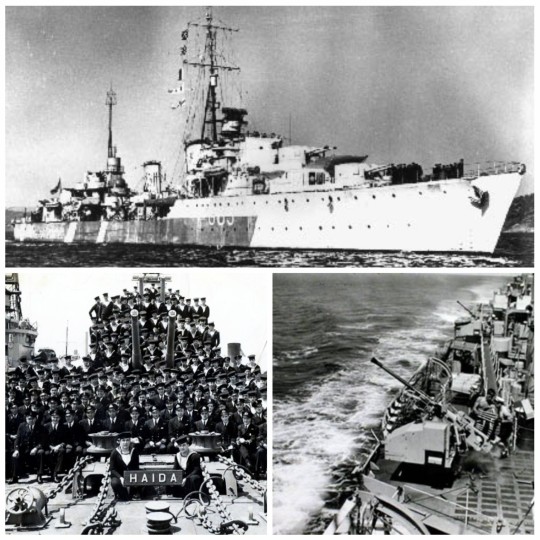
• HMCS Haida
HMCS Haida is a Tribal-class destroyer that served in the Royal Canadian Navy (RCN) from 1943 to 1963, participating in World War II and the Korean War. She was named for the Haida people.
The Tribals were designed to fight heavily armed destroyers of other navies, such as the Japanese Fubuki class. Canada chose the design based on its armament, with the size and power of the Tribal class allowing them to act more like small cruisers than as fleet destroyers. Haida was among the first batch of Tribal-class destroyers ordered by the RCN in 1940–1941. They were ordered with modified ventilation and heating systems for North Atlantic winter service. Haida's design was modified after deficiencies were noted in the lead ship of the Canadian Tribals, HMCS Iroquois. Haida, as one of the British-built Tribal-class destroyers, was 335 feet 6 inches (102.26 m) long between perpendiculars and 377 feet (115 m) long overall with a beam of 36 feet 6 inches (11.13 m) and a draught of 13 feet (4.0 m). As built, the destroyer displaced 1,927 long tons (1,958 t) standard and 2,745 long tons (2,789 t) at deep load. Haida had a complement of 14 officers and 245 ratings. As built, Haida was fitted with six quick-firing 4.7-inch (119 mm) Mk XII guns placed in three twin turrets. For secondary anti-aircraft armament, the destroyer was equipped with four single-mounted 2-pounder "pom-pom" guns. The vessel was also fitted with four 21-inch (533 mm) torpedo tubes for Mk IX torpedoes.
Haida's keel was laid down by Vickers-Armstrongs, Ltd. at their shipyard in Newcastle-upon-Tyne on September 29th, 1941. The destroyer was launched on August 25th, 1942 and commissioned into RCN service on August 30th, 1943. She underwent workups under her first commanding officer, H.G. DeWolf before reporting to the British Home Fleet at Scapa Flow in October 1943. After commissioning Haida was assigned to the Royal Navy's Home Fleet. On November 28th Haida was among the destroyer escort for the Russian convoy RA 54B, protecting it until it reached Loch Ewe on December 9th without loss. The convoy JW 55B sailed from Loch Ewe for Russia on December 20th. Haida was a member of its ocean escort. The German battleship Scharnhorst was deployed to intercept the convoy. While the cruisers escorting the convoy kept the German vessel at bay, Haida and the other escorting destroyers shepherded the convoy away from danger until the German battleship was sunk by a British force. Haida joined the escort of RA 55B on the return journey to the UK which sailed from Kola Inlet on December 31st and arrived on January 8th, 1944. On January 10th, 1944, she was reassigned to the 10th Destroyer Flotilla at Plymouth and took part in the Operation Tunnel and Operation Hostile sweeps in the Bay of Biscay and along the French coast of the English Channel.
By April, Haida had sailed on nineteen of the Operation Tunnel/Hostile missions. Haida continued the Operation Hostile sorties in company of sister ship Huron during the weeks leading up to Operation Overlord. The 10th Destroyer Flotilla were part of the covering force for surface attacks at the western entrance of the English Channel during the invasion of Normandy. On June 9th, Haida was part of Task Force 26 which engaged the German 8th Destroyer Flotilla, comprising Z32, Z24, ZH1 and T24 northwest of the Île de Bas. Following the fall of Cherboug, the German E-boats were transferred to Le Havre, freeing up the 10th Flotilla. The flotilla was then given the dual role of covering Allied motor torpedo boat flotillas and search and sink missions against German shipping along the French coast. On June 24th, while on patrol in the English Channel off Land's End, investigated a Liberator bomber dropping depth charges on a target. Haida and the British destroyer Eskimo began their own depth charge attacks after being informed that a submarine had been spotted. After several attacks, the submarine surfaced and attempted to run. Haida and Eskimo began to fire with all their guns and sank U-971. Haida rescued six survivors of the sunken submarine. On August 5th, Haida was part of a force engaged in an Operation Kinetic sweep. The force attacked a German convoy north of the Île de Yeu and sank the minesweepers M 263 and M 486, the patrol boat V 414 and the coastal launch Otto. During the battle a shell exploded in one of Haida's turrets and started a fire, killing two and injuring eight, knocking the turret out of action. Staying in the line of battle, the destroyers were engaged by shore batteries when they attempted to take on a second convoy and were forced to withdraw without doing much damage to the German merchant vessels.
Haida departed Western Europe on September 22nd for Halifax, Nova Scotia, arriving on September 29th. The destroyer returned to Scapa Flow in mid-January 1945 after refitting to receive new radar. In March Haida escorted aircraft carriers in minelaying operations off Granesund, Norway and assisted in attacks on shipping off Trondheim from March 24th-28th. On April 7th, Haida escorted seven anti-submarine warfare vessels from Greenock, Scotland destined for Soviet use at Vaenga, on the Kola Inlet. Haida experienced one of the last RCN engagements of the Second World War when she escorted convoy RA 66 from Vaenga from April 29th to May 2nd. The convoy was attacked in transit and Haida and Huron received near-misses from torpedoes fired by U-boats. In the skirmish, two U-boats were sunk, along with the frigate Goodall, and the convoy escaped in a snowstorm. Haida and Huron returned to Scapa Flow on 6 May and were assigned to relief operations at Trondheimsfjord, Norway on May 17th. Haida, along with Huron and Iroquois, left for Halifax in June to refit as part of Canada's contribution to Operation Downfall. They arrived on June 10th and Haida started a tropicalization refit but it was suspended after the surrender of Japan later that summer.
After the war, Haida was in inactive reserve for approximately one year but was prepared for reactivation in 1947 and underwent a refit for updated armament and sensors. This involved replacing the main armament, with the 4.7-inch guns removed and two twin Mk XVI 4-inch gun mounts installed forward and a twin 3-inch (76 mm)/50 calibre gun mount installed aft. Haida and her sister ship HMCS Nootka participated in exercises between the RCN's Atlantic Fleet and the United States Navy and Royal Navy over the next several years and were the first RCN ships to penetrate Hudson Bay in Fall 1948. Haida was involved in assisting during the grounding of the aircraft carrier HMCS Magnificent off Port Mouton, Nova Scotia on June 4th, 1949. In November 1949, Haida rescued the 18 members of the crew of a United States Air Force B-29 bomber that crashed in the Atlantic Ocean. The opening of the Korean War on June 25th, 1950 saw Haida once again activated for war duty. She was converted to a destroyer escort and began refit in July 1950 which saw various new armaments and sensors and communications systems. Following the Korean operations, Haida embarked on Cold War anti-submarine warfare duties with other NATO units in the North Atlantic and West Indies.
In 2002, at the urging of Hamilton, Ontario MP Sheila Copps, Parks Canada purchased Haida from the provincial government and towed her (with great difficulty) from her Ontario Place dock to a shipyard at Port Weller for a $5 million refit to her hull. She was taken to a new home on the Hamilton waterfront and arrived to an 11-gun salute from 31 Royal Canadian Sea Cadet Corps Lion and her 12-pounder naval field gun on August 30th, 2003, the 60th anniversary of her commissioning into the RCN.
#ww2#world war 2#world war ii#second world war#royal canadian navy#canadian history#history#british history#long post#british commonwealth#wwii
28 notes
·
View notes
Photo

“Sister-Ships To Cossack Are Building For Canada,” Toronto Star. May 22, 1940. Page 02. ---- Two New Destroyers Will Be Biggest, Fastest and Most Heavily Armed in Dominion’s Navy, Carrying 15 Guns and With 36.5 Knot Speed ---- Ottawa, May 22 (CP) - Sister ships of the illustrious H.M.S. Cossack of Altmark fame, two Tribal class destroyers are now under construction in Great Britain for the Royal Canadian Navy. They will be the largest, fastest, and most heavily armed destroyers in the service of this dominion, it was learned today.
Like the graceful, high-bowed Cossack, which rescued the British seamen on the German prison-ship and later participated in the Narvik campaign, the new Canadian vessels will mount eight 4.7 inch guns, four 21-inch torpedo tubes, and seven smaller quick-firing guns. They speed will be 36.5 knots.
The new destroyers will be of 1,870 tons displacement, compared with the 1,390 tons of the flotilla leader, H.M.S.C. Assiniboine, purchased earlier in the war and hitherto the largest Canadian destroyer.
Assiniboine ‘s main armament is 4.7 inch guns, half the number of the Tribal clsss, and she has six smaller guns compared to seven for the Tribal class, and eight 21-inch torpedo tubes compared with four in the Tribal class. Assiniboine‘s top speed is 35.75 knots compared with 36.5 for the Tribal class.
The new vessels will have a complement of 190 officers and ratings compared with 175 for the Assiniboine, and 44,000 horsepower from their turbnes compared with 36,000 turned up by the Assiniboine. The Tribal class overall waterline length is 355 1/2 feet, beam 36 1/2 and draught nine feet, compared with 326 feet length, 33 feet beam and 8 2/3 feet draught of the flotilla leader.
Only larger and more heavily armed vesssels of Canada’s navy will be the three merchantmen converted into light cruisers as mentioned by the prime minister in parliament Monday.
#royal canadian navy#world war II#canada during world war 2#tribal class destroyer#destroyer#h.m.s. cossack#h.m.s.c. assiniboine#flotilla leader#technical information#narvik#norwegian campaign#altmark#canada during world war II
3 notes
·
View notes
Photo

Fletcher-class Destroyer USS Keeling (call sign Greyhound), Tribal-class Destroyer HMS James (call sign Harry), and Flower-class Corvette HMCS Dodge (call sign Dicky) “Greyhound”
#Greyhound#Greyhound (movie)#Greyhound (2020)#WW2#Naval#GIF#my gifs#nautical#USS Keeling#HMS Harry#HMCS Dodge#Fletcher Class#Tribal Class#Flower Class#Danny watches Greyhound#Hide and Queue
53 notes
·
View notes